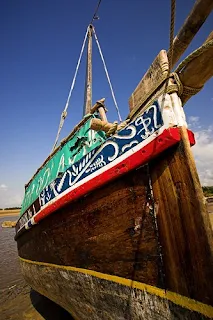The Ingenuity of African Entrepreneurs: Harnessing the Monsoon Winds for Trade
Entrepreneurship runs deep in African culture. The Axumite Kingdom used the monsoon trade routes to trade in spices ivory and gold with India, Arabia, and Southeast Asia.
The entrepreneurial drive and strategic positioning of the Axumite Kingdom along the Indian Ocean trade route enabled it to gain significant power and wealth through the monsoon trade network. The success of understanding nature through monsoon winds for sea trade highlights the ingenuity and hustle of the people of Africa. |
| Dhow ship used by Axumite Kingdom sailors |
The East African Axumite Kingdom used the monsoon trade routes and harnessed the power of the wind to trade in spices, ivory, and gold.
Africans have always been good at doing business, well before colonization. They had the skills and knowledge to trade goods and make money long before Europeans arrived.
The East African Axumite Kingdom developed many trade routes, like the monsoon trade route, in different areas of business. The impact of the monsoon trade on the Axumite Kingdom was significant. The Axumites were able to accumulate great wealth and influence through their participation in this trade network.
They traded in valuable commodities such as gold, ivory, and spices, which helped to fuel their economy and expand their power. The monsoon trade route allowed them to establish relationships with other cultures and kingdoms in India, Arabia, and Southeast Asia, facilitating the exchange of ideas, technology, and culture.
This also led to the spread of Axumite influence, as their culture and religion spread along with their trade. The trade route provided an avenue for the Axumites to access luxury goods and exotic materials, which would have been otherwise difficult to obtain.
The use of the monsoon trade route also demonstrated the adaptability and ingenuity of the Axumite people, who were able to navigate the challenges of the Indian Ocean and take advantage of the seasonal winds to create a thriving trade network.
This shows that Africans have been involved in the economy of Africa for a long time. In fact, they were entrepreneurs, which means they were good at starting and running their own businesses, even before Europeans came to Africa.
 |
| Axumite Kingdom traded in spices. |
Success of the Axumite Kingdom in harnessing the monsoon winds for sea trade highlights the long history of entrepreneurship in the people of Africa.
The Axumite Kingdom was a major player in the monsoon trade network, and its location on the Red Sea and Indian Ocean trade routes allowed it to amass great wealth and influence. Utilizing the monsoon trade routes is a testament to the ingenuity and adaptability of the African people who lived along the Indian Ocean.
For centuries, Africans have been resourceful in selling their goods and services, both domestically and across the Indian Ocean, using various methods on land and sea. In this case they were able to harness the power of the monsoon winds to create a thriving network of trade. The monsoon trade routes were a network of maritime trade routes that connected East Africa and India.
The term monsoon refers to the seasonal winds that blew across the Indian Ocean, which were critical for the transportation of goods and people along these routes. A monsoon is a seasonal shift in the prevailing wind patterns that typically brings heavy rain and wind.
The Axumite Kingdom was a powerful state that existed in present-day Ethiopia and Eritrea from the 1st century AD to the 8th century AD. The kingdom was known for its use of the monsoon trade route trading in ivory, gold, and spices.
Monsoon winds harnessed by the Axumite Kingdom sailors for trading.
Monsoon winds were harnessed by the Axumite Kingdom sailors who used traditional boats known as dhow's, which were designed to be able to navigate the challenging waters of the Indian Ocean.
The monsoon trade route was popular with sailors because of the predictable and reliable winds that blew across the Indian Ocean during the monsoon seasons.
During the summer monsoon season, June to October, winds blow from the southwest towards the Indian subcontinent, while during the winter monsoon season, November to May, winds blow from the northeast towards East Africa. This made it possible for sailors to plan their voyages and navigate the Indian Ocean with some predictability not taking into account the many storms and hazards that occur on the Indian Ocean.
 |
| Axumite Kingdom sailor. |
The Axumite Kingdom used wooden Dhow ships to navigate the monsoon trade winds.
Axumite Kingdom used a variety of ships for its maritime trade, including large wooden vessels known as dhows. Dhows were equipped with triangular sails that allowed them to catch the monsoon winds and navigate the open ocean.
They were also sturdy enough to withstand storms and other hazards of seafaring. The length of the voyage along the monsoon trade route varied depending on the distance traveled and the prevailing winds. For example, a voyage from the Red Sea port of Adulis to the Indian port of Broach could take up to six months, with sailors traveling more than 3,000 miles across the open ocean.
However, shorter voyages between ports along the East African coast and the Arabian Peninsula could take as little as a few days or weeks. The word dhow comes from the Arabic term daw, which means a small boat or canoe. A typical dhow ship has a long, narrow hull that tapers towards the bow and stern. The hull is usually made of wood, with planks fastened together using wooden pegs or nails. The hull is often painted in bright colors and decorated with intricate carvings.
The most distinctive feature of a dhow ship is its lateen sail, which is a triangular sail that is set on a long, sloping yardarm. The sail is often made of cotton or silk, and it is usually dyed in bright colors. The lateen sail allows the dhow to sail close to the wind and make efficient use of the prevailing monsoon winds.
 |
| Axumite Kingdom used a variety of ships for its maritime trade. |
Africans a long history of entrepreneurship, trade and commerce using the monsoon trade routes.
The Axumite Kingdom use the monsoon trade route to trade in spices ivory and gold with India, Arabia, and Southeast Asia. Over many years of trial and error, traders and sailors learned to navigate the monsoon winds and currents, developing techniques for managing their ships and predicting the weather. These skills and knowledge were passed down through generations of sailors, and eventually led to the establishment of large, prosperous trading networks that connected people and goods across the Indian Ocean.
For centuries, Africans have been resourceful in selling their goods and services, both domestically and across the Indian Ocean, using various methods on land and sea. The typical sailor on the monsoon trade route voyages from East Africa to India during ancient times was likely male, as seafaring was a male-dominated profession at the time.
Some of the common foods that were likely taken on these voyages include grains, dried fruits, nuts, seeds, and preserved meats. These would have been non-perishable foods that could last for long periods of time without refrigeration. Spices and herbs were also important commodities traded along the monsoon trade routes, and they were used to add flavor and preserve food.
The Axumite Kingdom of East Africa used the monsoon trade routes to trade in spices, ivory, and gold with India, Arabia, and Southeast Asia, which enabled the kingdom to gain significant power and wealth. The use of the monsoon trade route demonstrates the adaptability and ingenuity of the African people who were able to navigate the challenges of the Indian Ocean and create a thriving trade network. The monsoon trade routes were a network of maritime trade routes that connected East Africa and India. The Axumite Kingdom sailors used traditional boats known as dhows, which were designed to be able to navigate the challenging waters of the Indian Ocean.
It is important to acknowledge that Africans have been involved in the economy of Africa for a long time and have been entrepreneurs even before Europeans came to Africa. The Axumite Kingdoms' success in trading across the Indian Ocean is a testament to the resourcefulness and ingenuity of the African people.
Did you know? The people of the Axumite Kingdom were called the Axumites or Aksumites.
More links to articles you will find thought provoking.
- That African Fabric You're Wearing Isn’t African

- About neck elongation rings

-
Lighthouses of Egypt and Morocco

- Mental Illness in Africa Taboos

-
Kente cloth inspired by a spiders web







